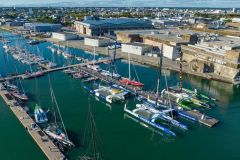The nautical sector, often at the forefront of technical innovation, faces a major challenge: reducing its environmental impact. Composite materials, essential for guaranteeing performance and lightness, are among the most difficult to recycle. However, recycled carbon, notably from the aeronautics industry, is now emerging as a credible solution. Two figures in ocean racing, François Gabart with MerConcept and Armel Tripon with its low-carbon IMOCA project, are pursuing separate initiatives in line with this dynamic.
MerConcept: structuring an industry for composites
MerConcept, founded by François Gabart, is committed to creating a circular economy for composites. In collaboration with Extracthive, a specialist in complex materials, the company is tackling the recycling of carbon fibers from end-of-life boats. At present, most of this waste is landfilled or incinerated, an unsustainable solution.
François Gabart insists on the need for change: " Today, only 5% of composite materials are recycled worldwide. It's crucial to find solutions for reclaiming these materials and reintegrating them into our production chains. "
MerConcept is developing processes for recovering fibers while preserving their mechanical properties. These fibers could be used not only in shipbuilding, but also in other sectors, thus expanding the outlets for recycled carbon. To begin with, MerConcept has produced ballast vent dorades on Charlie Dalin's IMOCA Macif, for the Vendée Globe 2024, made from 100% recycled carbon fibers. The company soon hopes to produce other parts using this process.
Armel Tripon: an innovative, low-carbon Imoca

Meanwhile, Armel Tripon is embarking on an experimental approach by building an Imoca destined for the Vendée Globe 2028. Made with 70% decommissioned carbon fibers from the aeronautical industry, this boat should reduce the emissions linked to its construction by 50%, i.e. around 300 tons of CO? saved compared with production using conventional materials.
Armel Tripon explains his approach: " Using recycled carbon meets a dual requirement: maintaining performance while reducing environmental impact. Every kilogram of new carbon avoided is a step forward. "
The project, carried out in Malville, in a dedicated yard provided by Duqueine Atlantique, a subcontractor of Airbus, the boat's builder and sponsor, mobilizes advanced technologies and also emphasizes the valorization of other heavy waste materials, such as titanium. Titanium, recycled from the medical sector, is used in the fittings of the IMOCA, which carries the colors of a hospital association.
Key figures for recycling in the marine sector
Recycling in the boating industry is still a marginal issue, but the outlook is promising:
- In 2022, some 55,000 tonnes of composite waste were generated by the marine industry in Europe, according to a study by the International Boat Industry (IBI).
- Only 2,000 tonnes of composites were recycled, i.e. less than 4% of total volumes.
- The reuse of carbon fibers could reduce emissions linked to the construction of hulls and masts by 30-50%, according to data from the European Environment Agency.
These statistics show the scale of the challenge ahead, but also the potential of projects like those of François Gabart and Armel Tripon to further systematize recycling.
Technical and economic challenges
Despite their potential, recycled composites are not without their constraints. The processes used to separate the resins from the fibers are costly and energy-intensive. They require advanced technology to guarantee sufficient quality in the recovered fibers. François Gabart points out: " Recycling is the first step, but we need to ensure that the fibers reintegrated into new materials retain their optimum mechanical properties. "
For Armel Tripon, the challenge is to demonstrate that these recycled fibers can withstand the extreme conditions of a race like the Vendée Globe. His IMOCA will serve as a full-scale test to evaluate the durability of the materials in the field.
Towards widespread recycling?
The initiatives of François Gabart and Armel Tripon show that recycling composites is possible and relevant, but their widespread adoption will require significant investment. According to a Boat Digest study, a 20% increase in recycling capacity in Europe could enable the processing of up to 12,000 tonnes of composite waste per year by 2030.
However, the economic viability of recycling will depend on lower costs and greater awareness among industry players. For François Gabart: " It's a collective responsibility. If everyone gets involved, lasting solutions can quickly emerge. "









